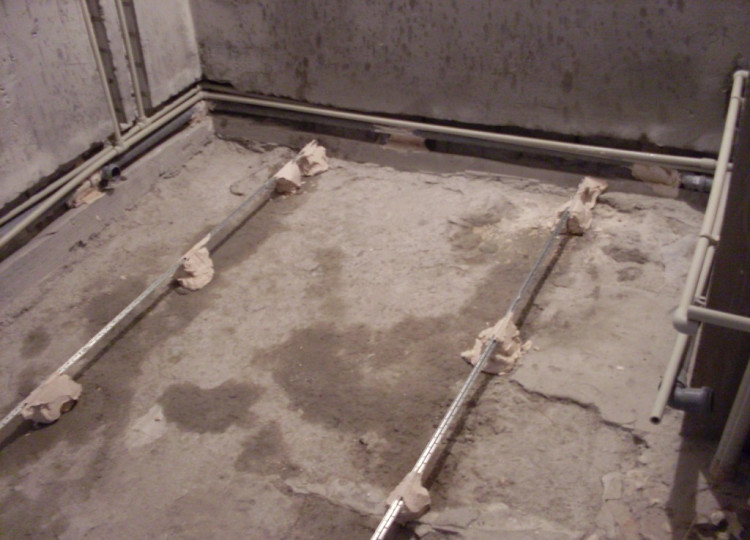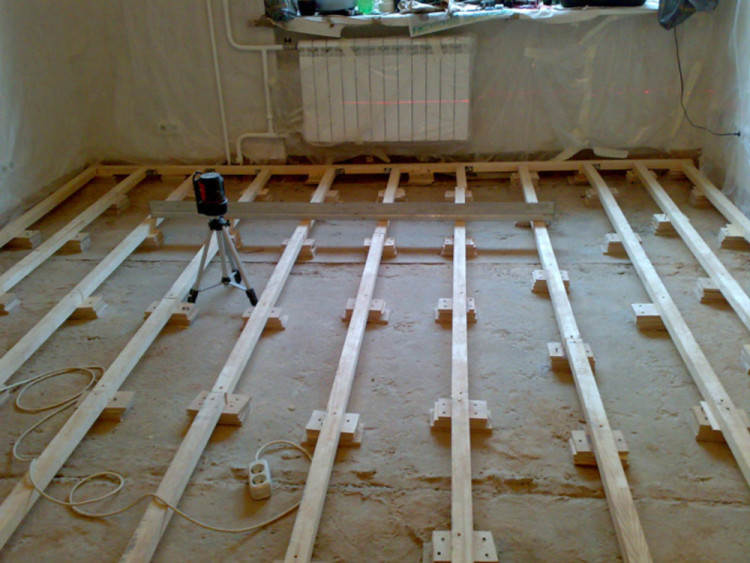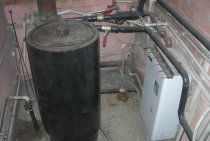How to raise the level of the floor
The floor level is raised to avoid height differences in front of the bathroom or toilet. If it is necessary to raise the floor level by 10 centimeters or less, then a concrete screed of the required thickness is poured.
For screed, a cement-sand mixture with the addition of crushed stone is used. For one part of cement grade not lower than 300, 3 parts of sand and 4-6 parts of crushed stone are taken. Such filling is performed on concrete floors.
If the floors are made of wood, the concrete screed will bring them down. For such floors, a frame is made of wooden bars and a floorboard or moisture-resistant plywood with a thickness of at least 20 mm.
Before raising the floor, lay a new sunbed with the required slope, or increase the slope of the old one. Fasten the pipes.
To pour the screed, clean the floor of dirt and debris. Lay a reinforcing mesh of steel or fiberglass reinforcement on the floor. The mesh will prevent cracking of the screed. Then install formwork to raise the level of the floor in the separate room.
Set the beacons (wooden or metal guides) to the level. They are necessary to create a smooth horizontal surface of the screed. Install beacons on wooden bars or bricks. Before pouring, check the beacons again with a level. If the deviation is more than 2 mm per 2 meters, align.
Beacons for pouring screed
Thoroughly mix the concrete with a drill or hammer attachment. Ready concrete is a homogeneous mass without lumps and inclusions of dry sand or cement. Moisten the floor and pour concrete. Level the concrete with the board on the lighthouses. The screed will gain full strength in 25 days.
To raise the level of the floor on a hardwood floor, purchase wooden blocks 50 mm thick. Determine the width by the formula - the difference in the heights of the ceiling and the new floor level minus the thickness of the plywood (floorboard).
From the bars make logs - guides for plywood. Lay them across the room, the distance between the lags is 40-50 cm. At the installation site of the bath or toilet, the distance between the lags is 20-30 cm. Cover the logs with plywood or a floorboard. Dock the flooring only on the logs. Do not allow boards or sheets to be joined in a space without a lag.
Logs for wooden floors
These methods raise the level of the floor both in the entire room and in a separate part. Raising the floor level in one part of the room reduces the load on the ceiling and reduces the consumption of materials.
After the floor level has been raised, install and connect the plumbing. If you did everything right, then the slope of the lounger will be optimal, the drainage of fecal and waste water will improve and the chance of blockage will be reduced tenfold.
The operation of the sewer depends on the correct slope. Deviations from the slope recommended by SNiP reduces the efficiency and reliability of sewage. From the article, you learned what the correct slope should be, how the slope is changed, and why it is undesirable to touch the sewer riser. You have learned how to raise the level of the floor on wooden and concrete floors and thus change the slope of the sewer.
How sewer works
Water is drained into the sewer from the toilet bowl, sink, bathtub, washing machines and dishwashers and other devices. This water contains organic impurities ranging in size from hundredths of a millimeter to several centimeters. The composition and amount of impurities are different, so the sewage system is calculated in such a way that drain and fecal water passes without delay.
The calculation method is described in SNiP 2.04.01-85. If we simplify the formulas, then the correct slope depends on the flow rate of sewage and fecal water and the diameter of the pipes. For thin pipes (40-50 mm) it corresponds to 2-3 cm per meter of length, for thick pipes (90-110 mm) 1-2 cm.If the slope is less, then large fragments of fecal and sewage get stuck in the joints of the pipes, and small ones are caught on the unevenness and roughness of the pipe.
The low flow rate does not allow water to break off stuck or stuck fragments, resulting in a blockage. With an excessive slope, the water speed increases, so the fragments hit the bumps with more force, so some of them stick to the pipes and form a blockage. Another unpleasant manifestation of excessive pipe slope is increased noise when draining water.
The slope is the difference in the heights of the water inlets of the horizontal collector (lounger) and the inlet of the vertical common house collector (riser). Therefore, the slope depends on the height of the hole in the riser, the level of the floor and the height of the receiving hole of the lounger above the floor.




